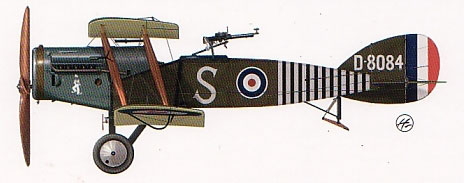S u m m a r y
|
| Publisher and
Catalogue Details: |
Osprey Aircraft of the
Aces #79 Bristol F2 Aces of World War 1 by Jon Guttman |
| ISBN: |
9781846032011 |
| Media and
Contents: |
Soft cover, 96 pages |
| Price: |
GBP£12.99 online from Osprey Publishing
|
| Review Type: |
FirstRead |
| Advantages: |
Interesting well written text, relevant period photographs,
excellent artwork. |
| Disadvantages: |
|
|
Recommendation: |
Highly Recommended
|
Reviewed by Rob Baumgartner

Osprey's Bristol F2
Aces of World War 1 is available online from Squadron.com
Most World War I aficionados would be familiar with the likes of
Richthofen, McCudden, Baracca and Fonck. It didn’t take long for these
single seat “drivers” to grab the public’s attention.
But how many would recognize names such as Atkey, Gurdon, Latimer or
McKeever?
These were the top scoring aces of the “Biff”, and each had over 25
victories to their credit. Not to be forgotten are the observers, with
such luminaries as Gass, Fletcher, Hayward and Noel also coming to the
fore. They too scored heavily with Gass in particular attaining an
amazing 39 conquests.
Being two-seater aircraft, the F2A and F2B did not have the glamour of
their single seat cousins. Yet their role was no less important in
gaining valuable intelligence and harassing the enemy.
This book covers the exploits of the brave men that flew in these
machines.
Within the 96 pages the author tells the tales of both front and back
seat fliers in a style that is both entertaining and informative. A
bonus is the narrative provided by the aircrew themselves which is
punctuated throughout the text.
Complimenting this are over 100 period black and white photographs. They
are well chosen for their relevance and are accompanied by enlightening
captions.
 Harry
Dempsey does his usual sterling work with the colour profiles and 28
aircraft are represented. Where necessary, plan views are provided to
show marking details that are hidden on the main image.
Harry
Dempsey does his usual sterling work with the colour profiles and 28
aircraft are represented. Where necessary, plan views are provided to
show marking details that are hidden on the main image.
Jon Guttman begins the book by describing the disastrous debut of the
F2A.
It was 48 Squadron’s first offensive patrol and it came across
Richthofen’s Jasta 11. Four of the six F2As were shot down, the
remaining two limping home riddled with bullet holes.
The problem lay not with the aircraft but how it was handled. The pilots
were told to adopt the standard two-seater tactic of keeping together to
allow the rear gunners to provide mutual protection for each other. This
negated the excellent speed and maneuverability of this fighter. When
the F2 was used offensively, as if it were a “Scout”, it quickly became
a potent weapon.
It wasn’t long before the improved F2B followed and the features of
the new arrival are explained along with the reasons for its
introduction.
He continues with the fortunes of 48 Sqn, before introducing No 11 Sqn.
in chapter two.
The third unit to attain the Bristol fighter was No 22 Sqn and they
round out the remainder of this section.
The British system of confirming victories was quite lenient, helped no
doubt by most of the victories occurring over enemy territory. Bearing
this in mind, No 20 Sqn. can claim to be the highest scoring fighter
unit of World War One. Their story is captured in chapter 3.
It wasn’t just reconnaissance duties that occupied the Bristol Fighter.
A section on the air superiority duties of Nos 62 and 88 Sqns follows,
their role often being the protection of DH 4 and DH 9 aircraft on
bombing missions.
The Sqns that operated away from the Western Front round out the book
with this area covering Italy, Palestine, and the Middle East.
A handy appendix lists the pilots and observers that became aces as well
as their totals obtained in other aircraft types. This is cross
referenced to the serial numbers of the Biffs they used for these
accomplishments…a handy guide for modelers.
To give the reader a better impression of what the machine looked like,
a set of 1:48 scale general arrangement drawings are also included.
Two-seater aircrew are not often though of as being aces, this being
reserved for their more famous single seat brethren.
Jon Guttman brings these forgotten airmen to life and gives the reader a
real appreciation of the courage and bravery they displayed. The
research is first class and is presented in a package that will delight
all enthusiasts of World War I warfare.
Highly Recommended
Thanks to
Osprey Publishing for the review sample
Review Copyright © 2007 by Rob Baumgartner
Page Created 08 November, 2007
Last updated
24 December, 2007
Back to
HyperScale Main Page
Home
| What's New |
Features |
Gallery |
Reviews |
Reference |
Forum |